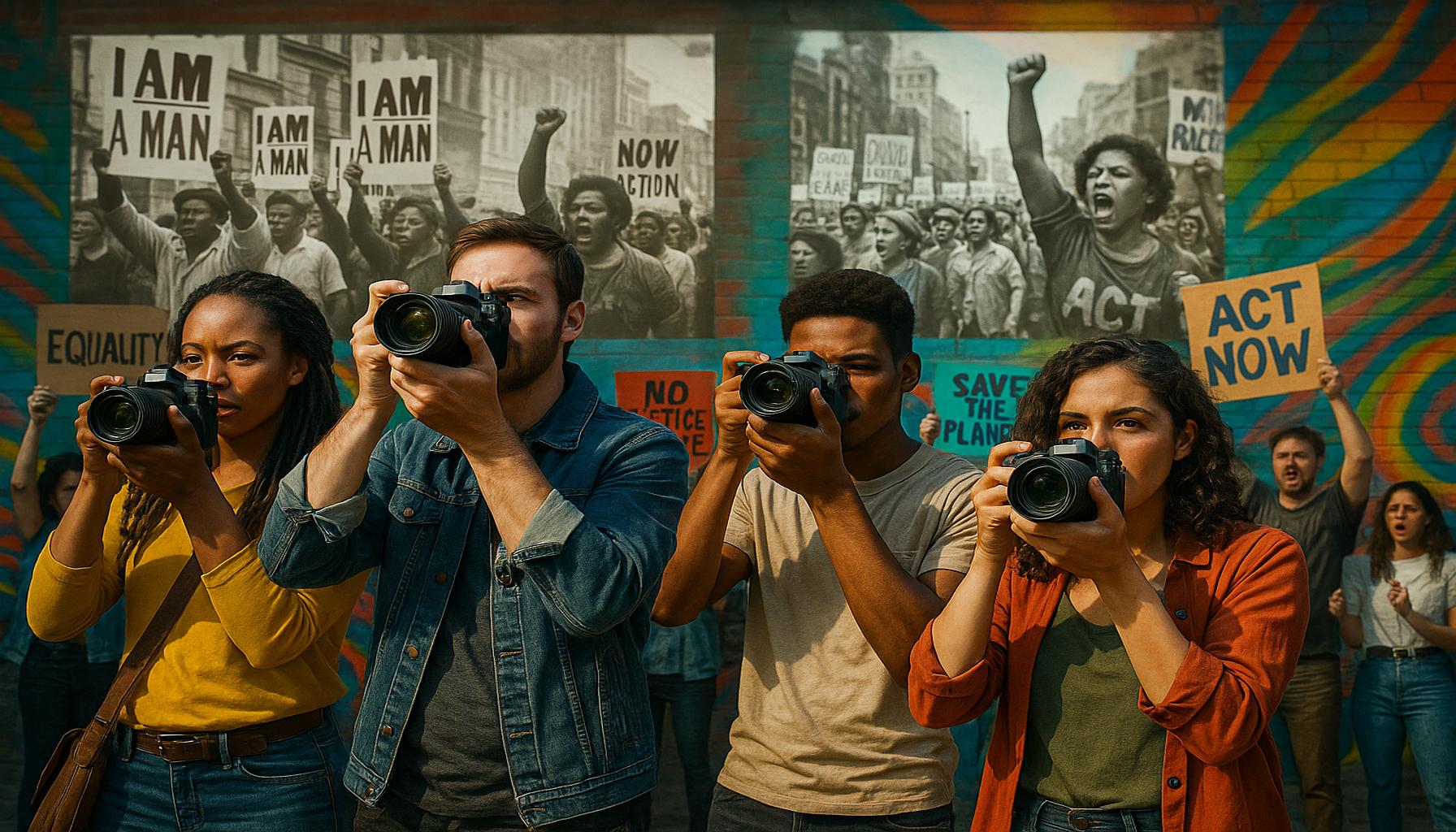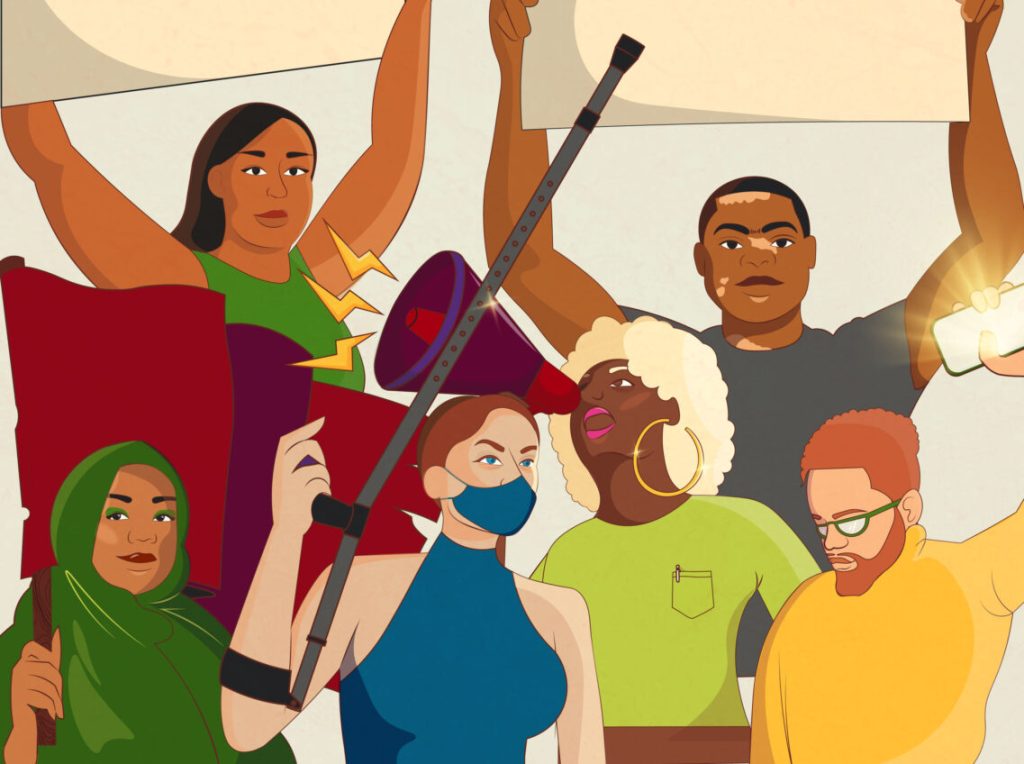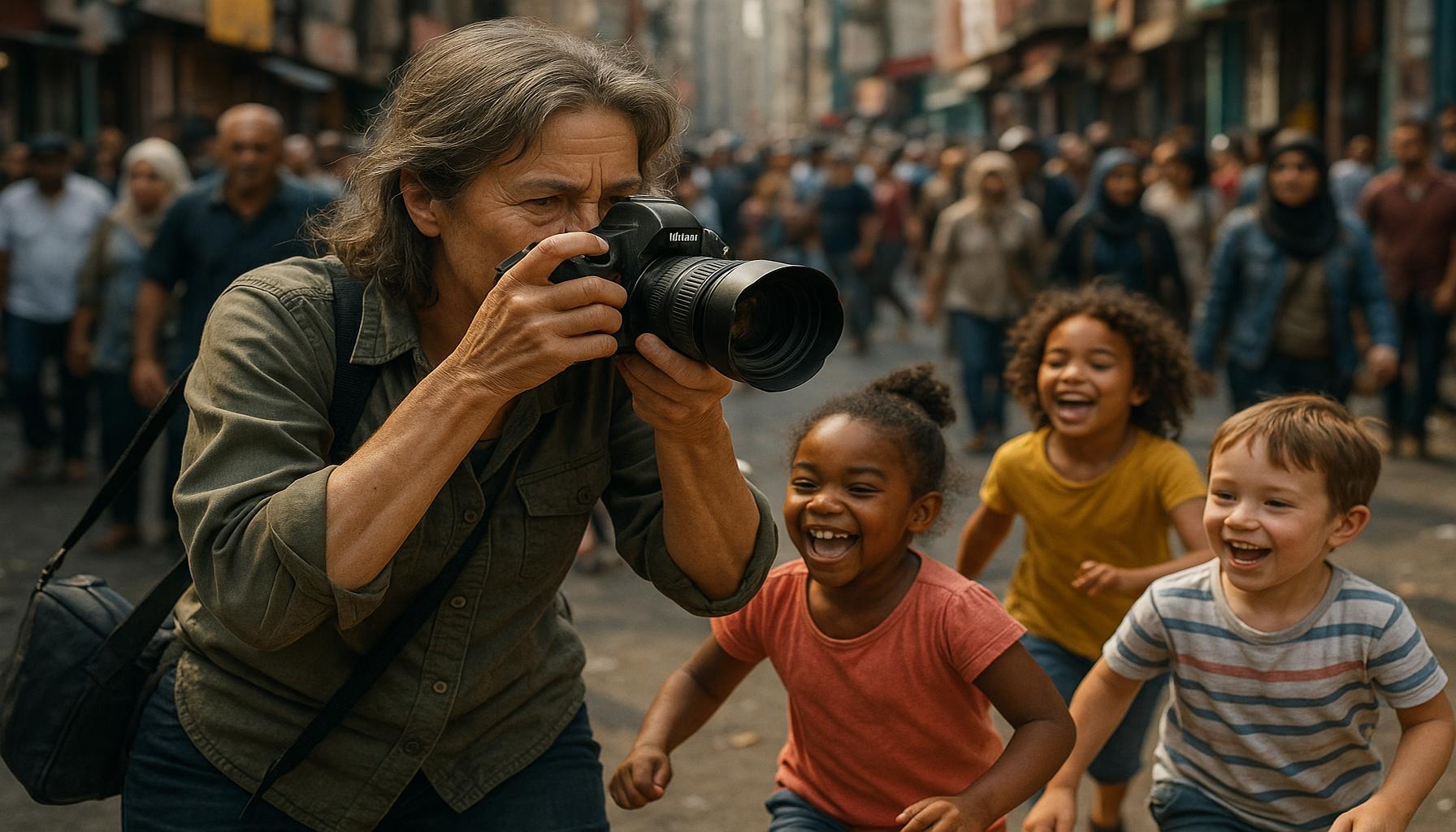The Impact of Photography on Social Activism: Telling Stories and Generating Change

The Power of Photography in Social Activism
In an increasingly interconnected world, the role of photography in social activism has become more vital than ever. Through visual narratives, photographers document critical issues, providing a visual voice to the voiceless and shedding light on topics often overlooked by mainstream media. Each photograph can convey complex emotions and provoke conversations that resonate deeply with viewers, making it a unique medium for activism.
Visual Storytelling
Visual storytelling allows photographers to craft narratives that can bypass linguistic barriers and cultural divides. The emotional weight carried by an image can often speak volumes where words might falter. For example, the powerful image of a mother clenching her child in a desperate embrace during the migrant crisis not only portrays desperation but also humanizes the statistics plastered across news outlets. Such images have the capacity to elicit empathy and catalyze action, often prompting viewers to reconsider their stance on complex social issues.
Documenting Reality
Photography serves an essential role in documenting reality, particularly in providing an unfiltered view of the lives of marginalized communities. For instance, during the Civil Rights Movement in the United States, photographers like Gordon Parks captured the stark realities of segregation and racial injustice, forging a historical record that remains transformative. These visual archives not only educate future generations but also serve as a powerful reminder of struggles overcome, igniting a continued fight for equality.
Mobilizing Support
Another significant aspect of photography in activism is its capacity for mobilizing support. Striking visuals can trigger a sense of urgency that drives people to take action, whether it’s joining a protest, signing petitions, or donating to causes. The viral photograph of a protester confronting a line of armed police during the Black Lives Matter movement galvanized numerous individuals, leading to widespread participation in marches and community organizing efforts across the country. These images invigorate collective efforts by transforming passive observers into active participants.
The Evolution of Activist Photography
As technology continues to advance, the medium of photography has evolved significantly. The rise of social media platforms such as Instagram and Twitter has democratized the dissemination of images, allowing activists to share powerful visuals instantly with a global audience. A poignant photo can go viral within hours, reaching thousands—or even millions—of viewers, heightening awareness and urgency around social causes.

In an era where perception is often reality, the ability of photography to generate significant societal change cannot be understated. By visually confronting the public with pressing social issues, the medium transcends mere representation, serving as a catalyst for conversation and action. The following sections will further explore the profound intersection of photography and activism, illustrating how this dynamic relationship continues to shape society and influence perceptions worldwide.
DIVE DEEPER: Click here to discover the impact of collaboration on musicians
The Role of Visual Narratives in Fostering Change
Photography is a powerful form of visual narrative that goes beyond mere aesthetics; it is an instrumental tool in the realm of social activism. By capturing raw, authentic moments, photographers play a pivotal role in bringing social issues into the public sphere. The visual representation of struggles and triumphs ignites dialogues that may otherwise remain dormant, impacting societal perceptions significantly. Through the lens of a camera, compelling stories unfold, leaving a long-lasting impression on the audience.
The Emotional Connection through Imagery
One of the most striking aspects of photography in activism is its ability to establish an emotional connection with viewers. An evocative image can tell a story—sometimes better than words ever can—eliciting feelings of empathy, outrage, or hope. For example, the iconic photograph of the “Napalm Girl”—Phan Thị Kim Phúc running from a napalm attack during the Vietnam War—serves as a haunting reminder of the costs of war and human suffering. Such images resonate on a personal level and often mobilize communities to speak out against injustices.
Shaping Public Discourse
Photography not only evokes emotions but also shapes public discourse surrounding critical issues. Photographers serve as documentarians who highlight systemic issues—ranging from poverty and environmental degradation to human rights violations. By providing a visual context, they create a narrative that can challenge established norms and encourage discussions that might lead to action. A recent example is the series of photographs emerging from the climate crisis. Dramatic visuals of wildfires, floods, and melting glaciers are used to educate and motivate people regarding environmental reforms.
The Accessibility of Photography in Activism
In today’s digital age, the accessibility of photography has transformed the landscape of activism. Now, anyone equipped with a smartphone can capture moments and share them on social media platforms like Facebook, Instagram, and TikTok. This democratization of photography enables grassroots movements to gain visibility without relying solely on traditional media channels. Some critical benefits of accessible photography in activism include:
- Immediate Reach: A powerful image can be shared instantaneously with a global audience, creating immediate engagement.
- Fostering Community: Individuals with shared interests can rally around images that resonate with their experiences.
- Raising Awareness: The ability to share images widely enhances awareness on a scale previously unimaginable, drawing attention to lesser-known causes.
Understanding the Ethics of Photographic Activism
As photography continues to play a transformative role in social activism, it is crucial to also consider the ethical implications of such visual narratives. Issues surrounding consent, representation, and the potential for exploitation must be taken into account. Photographers have a responsibility to navigate these terrain delicately, striving for authenticity while maintaining respect for the subjects they depict. In a world where images are often manipulated, ethical guidelines serve to ensure that the integrity of the story is upheld and that the voices of those represented are honored.
As we delve deeper into the interwoven relationship between photography and social activism, it becomes evident that the impact of images extends far beyond mere visuals—they are catalysts for change. Through ongoing exploration, we can fully appreciate the profound role photography plays in telling stories that resonate, provoke, and inspire action.
| Advantages | Description |
|---|---|
| Emotional Engagement | Photography captures deep emotions, making the viewer empathize with subjects, enhancing awareness on social issues. |
| Historical Documentation | Images serve as powerful records, chronicling movements and events that define social change throughout history. |
| Viral Potential | Compelling photographs can easily spread across social media platforms, boosting the visibility of critical causes. |
| Inspiration for Action | Photographs not only inform but also inspire viewers to take action towards activism and community engagement. |
In the digital age, photography serves as a formidable weapon in the fight for social justice. The visual clarity that a striking image provides can articulate experiences that words may fail to encompass. Whether depicting struggles against inequality, environmental degradation, or human rights abuses, the power of a single photograph can resonate globally and ignite movements. Moreover, initiatives like street photography or photojournalism highlight communities often overlooked, enabling their narratives to breach mainstream consciousness. Furthermore, with the rise of social media, activists leverage hashtags and trending images to create movements that capture the attention of millions. This exponential sharing not only raises awareness but also influences public discourse, creating a ripple effect demanding change. As we scrutinize the fabric of social activism today, it’s clear that photography is not merely a tool for documenting events but a catalyst that drives profound societal transformations. It’s a call to action for both photographers and viewers to embrace their role in this evolving landscape.
DIVE DEEPER: Click here to discover vibrant watercolor techniques
Photography as a Catalyst for Grassroots Mobilization
As we continue to unravel the multifaceted role of photography in social activism, it becomes apparent that images can serve as a potent catalyst for grassroots mobilization. Photographs possess the unique ability to transcend language barriers, making them accessible vessels for messages that can resonate universally. This characteristic is exemplified in campaigns such as Black Lives Matter, where central images, like the haunting shirts and signs held by protestors, encapsulate the movement’s fight against racial injustice and police brutality. These photographs not only convey the sentiments of those involved but also create a unified visual language that spreads easily across diverse communities.
The Power of Virality
In our fast-paced digital world, the concept of virality plays a significant role in amplifying activist messages through photography. The advent of social media has allowed striking images to travel lightning-fast, reaching millions in mere moments. This phenomenon was witnessed during the Women’s March in 2017 when images of participants wielding poignant signs flooded platforms like Twitter and Instagram. These snapshots not only documented the vast turnout but also solidified a collective identity, bolstering the call for gender equality. Photography, therefore, becomes not just documentation but a social currency that fuels movements, invigorates supporters, and holds powers accountable.
Influencing Policy Making
Beyond mobilization, photography has the capacity to influence policy making at various levels. Visual evidence of social issues can trigger inquiries, stimulate debate, and lead to legislative changes. Photographers capturing the devastating effects of water contamination in places like Flint, Michigan, have played an essential role in bringing this crisis to national attention. Their images serve as a stark reminder of the human impact of policy decisions, spurring public outcry and prompting politicians to confront these pressing matters. Indeed, the fusion of powerful imagery and strategic advocacy can result in policy reforms that shape the future of communities.
Challenging Stereotypes and Misconceptions
Through its authentic representation of diverse experiences, photography also serves as a tool for challenging long-held stereotypes and misconceptions. For instance, during the immigration crisis, images depicting the daily lives of migrants have helped humanize their narratives, dispelling the dehumanizing rhetoric often associated with them. This nuanced portrayal allows audiences to connect with populations previously seen through a distorted lens, fostering a deeper understanding and compassion. By shedding light on the realities of marginalized groups, photographers play an essential role in promoting inclusion and empathy.
The Emergence of Activist Photographers
In response to the growing recognition of the impact photography can have in activism, a new wave of activist photographers has emerged. Many are driven by the desire not just to document but to engage with communities deeply. This involves listening to the subjects’ stories, ensuring their voices and perspectives are represented authentically. Projects like Humans of New York have demonstrated the efficacy of personal storytelling through imagery, highlighting the importance of individual narratives in the larger context of activism. Such practices challenge traditional norms of photojournalism, emphasizing collaboration and co-creation, and paving the way for a more equitable representation of social issues.
Through the fusion of creativity, technology, and community engagement, photography continues to reshape the landscape of social activism. By facilitating dialogue, fostering mobilization, and influencing policies, its role has never been more crucial in the fight for social justice. As we delve deeper into this evolving field, the potent intersection of photography and activism promises to inspire profound changes well into the future.
DIVE DEEPER: Click here to uncover the evolution
Conclusion: The Lasting Influence of Photography in Social Activism
As we reflect on the transformative impact of photography in social activism, it is clear that images serve as powerful tools for storytelling and advocacy. Through their ability to evoke emotions and encapsulate complex narratives, photographs transcend barriers, prompting audiences to confront realities that might otherwise remain hidden. The efficacy of photography in mobilizing communities, influencing policymakers, and challenging stereotypes cannot be overstated. Striking visuals have the potential to ignite passion and urgency, making social issues more tangible and urgent.
Moreover, the rise of activist photographers has further redefined the landscape of visual storytelling by prioritizing authentic representation and community partnership. These individuals not only document struggles but actively engage with the subjects of their work, ensuring that diverse voices are heard and valued. This evolution enhances the overall impact of activism, fostering empathy and understanding in a society that often struggles with divisiveness.
As technology continues to advance, the role of photography in activism will likely expand, embracing new platforms and innovative ways to disseminate powerful messages. As we march forward, it is essential to recognize and support the critical interplay between creativity and advocacy, encouraging a future where stories captured in frames continue to inspire meaningful change. Ultimately, the lens of a camera does more than capture moments—it has the potential to shape narratives, ignite movements, and transform society.



